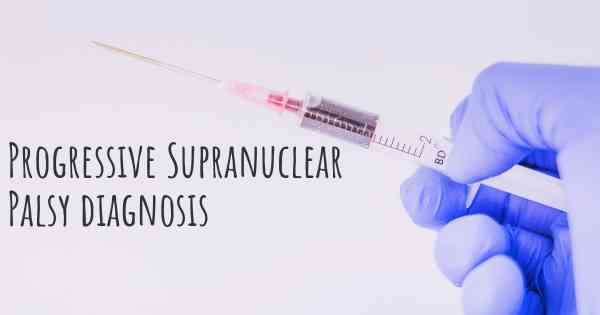How is Progressive Supranuclear Palsy diagnosed?
See how Progressive Supranuclear Palsy is diagnosed. Which specialists are essential to meet, what tests are needed and other useful information for the diagnosis of Progressive Supranuclear Palsy

Diagnosing Progressive Supranuclear Palsy (PSP)
Progressive Supranuclear Palsy (PSP) is a rare neurodegenerative disorder that affects movement, balance, and cognition. Diagnosing PSP can be challenging as its symptoms can overlap with other conditions, such as Parkinson's disease and Alzheimer's disease. However, there are specific criteria and diagnostic tests that doctors use to identify PSP.
Clinical Evaluation
The first step in diagnosing PSP is a thorough clinical evaluation by a neurologist or movement disorder specialist. The doctor will review the patient's medical history, including symptoms and their progression over time. They will also conduct a physical examination to assess motor skills, eye movements, balance, and coordination.
Diagnostic Criteria
The Movement Disorder Society (MDS) criteria are widely used for diagnosing PSP. These criteria include:
- Gradually progressive disorder: Symptoms worsen over time.
- Supranuclear gaze palsy: Difficulty moving the eyes vertically and/or horizontally.
- Early falls: Frequent unexplained falls within the first year of symptom onset.
- Postural instability: Impaired balance and unsteady gait.
- Additional features: Other symptoms like cognitive impairment, speech and swallowing difficulties, and behavioral changes.
- Exclusion criteria: Ruling out other conditions that may cause similar symptoms.
Neurological Examination
A comprehensive neurological examination is crucial for diagnosing PSP. The doctor will assess various aspects, including:
- Ocular motor function: Eye movement abnormalities, such as vertical gaze palsy, difficulty tracking objects, and impaired blinking.
- Motor function: Evaluation of muscle strength, coordination, and reflexes.
- Posture and gait: Assessing balance, stability, and walking pattern.
- Cognitive function: Testing memory, attention, language, and executive functions.
Neuroimaging
Neuroimaging techniques can provide valuable insights into the brain structure and help rule out other conditions. Magnetic Resonance Imaging (MRI) is commonly used to detect specific patterns associated with PSP. The MRI may reveal:
- Midbrain atrophy: Shrinkage of the midbrain, a characteristic finding in PSP.
- Hummingbird sign: A thinning of the midbrain that resembles a hummingbird's body on a cross-sectional view.
- Hummingbird sign: A thinning of the midbrain that resembles a hummingbird's body on a cross-sectional view.
- Hot cross bun sign: Atrophy in the pons, a region of the brainstem, which appears as a cross-like shape on imaging.
Cerebrospinal Fluid Analysis
An examination of the cerebrospinal fluid (CSF) can be helpful in the diagnostic process. A lumbar puncture, also known as a spinal tap, is performed to collect a sample of CSF. The analysis may reveal elevated levels of tau protein, which is associated with PSP and other neurodegenerative disorders.
Genetic Testing
While most cases of PSP are sporadic, genetic mutations can contribute to the development of the disease in some individuals. Genetic testing may be considered, especially in cases with a family history of PSP or when symptoms manifest at an unusually young age.
Second Opinion
Due to the complexity of diagnosing PSP, seeking a second opinion from a movement disorder specialist or a neurologist experienced in PSP can be beneficial. They can review the patient's medical history, conduct additional tests if necessary, and provide a more accurate diagnosis.
Note: It is important to remember that diagnosing PSP can be challenging, and the process may vary depending on the individual. Consulting with a healthcare professional is essential for an accurate diagnosis and appropriate management of the condition.
Posted Aug 12, 2017 by Diana Sanders 2000
Posted Dec 31, 2018 by Kerryn 720
Posted Jul 5, 2019 by Loretta 800
Posted Nov 8, 2017 by Maria Veronica Ortiz Solís 2000








